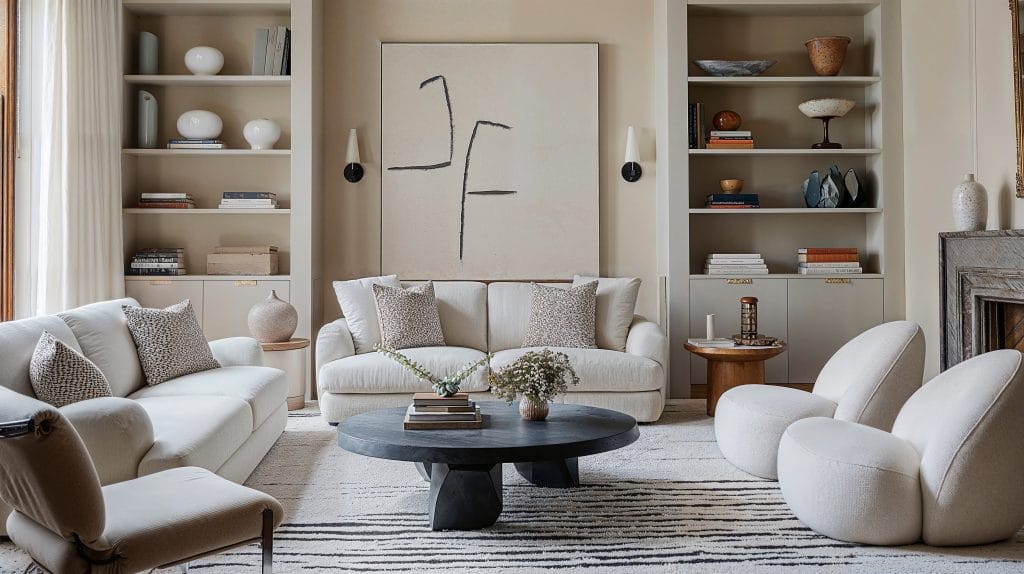Transform Your Home With Necessary Principles of Interior Decoration and Aesthetics
By recognizing the influence of shade theory and the value of appearance and patterns, one can develop areas that are not just aesthetically appealing but likewise deeply individual. Achieving this balance entails more than simple decoration; it includes a strategic arrangement and a keen understanding of exactly how each component interacts within an area.
Comprehending Color Concept
Color concept is a basic aspect of interior decoration that significantly affects state of mind, understanding, and total aesthetic. Understanding the concepts of color concept allows designers to produce rooms that reverberate emotionally with owners while satisfying functional needs (luxury interior design). Colors can be classified right into 3 main kinds: primary, secondary, and tertiary. Each group plays an important duty in establishing consistency within a space.
The psychological influence of shades is profound; warm tones such as reds and oranges stimulate energy and warmth, while trendy tones like blues and greens promote calmness and harmony. The usage of complementary shades improves aesthetic rate of interest, developing striking contrasts that can boost a room's appeal.
Neutral shades, on the various other hand, function as a versatile background, permitting other layout components to beam. It is important to consider variables such as lighting and the room's objective when choosing a color scheme, as these can change the perception of shades throughout the day.
Ultimately, a well-considered color pattern can transform a room, fostering a sense of comfort and style that straightens with the occupants' preferences. Mastery of color theory is, consequently, a vital ability for any type of indoor designer intending to produce unified and inviting settings.
Attaining Equilibrium in Design
Exactly how can developers attain a sense of equilibrium in their areas? Accomplishing balance in style is fundamental to creating unified insides.
Unbalanced balance, on the various other hand, depends on varying aspects that still achieve a natural appearance. This strategy enables for even more dynamic and casual plans, offering rate of interest while keeping balance. By very carefully picking differing sizes, shades, and appearances, developers can create an aesthetically compelling area that feels balanced yet energetic.
Radial balance highlights a central focal point with aspects emitting external. This design is frequently seen in round designs, where furniture and decor develop a cohesive border that draws the eye internal.
Eventually, attaining equilibrium calls for thoughtful factor to consider of range, proportion, and the connections in between components. miami interior design. By skillfully using these balance concepts, designers can transform spaces into atmospheres that feel both visually pleasing and functionally unified, enhancing the overall experience for residents
Importance of Spatial Recognition

An eager sense of spatial recognition allows developers to recognize centerpieces within a room, leading the audience's interest to crucial attributes while keeping a total feeling of unity. It likewise assists in the critical discover here positioning of lights, which can drastically influence the understanding of area and state of mind. In addition, recognizing spatial connections enables the designer to satisfy the certain demands of inhabitants, ensuring that each area offers its desired purpose without compromising looks.
Inevitably, spatial recognition is vital for making best use of the possibility of any indoor area. By thoroughly considering the interaction in between dimensions, layout, and function, developers can produce environments that not just meet sensible demands yet likewise evoke a feeling of comfort and elegance, improving the total living experience.
Including Appearance and Patterns
Accepting a varied series of textures and patterns can substantially enhance the aesthetic and tactile appeal of an indoor space. The critical use numerous materials-- such as wood, steel, material, and rock-- creates deepness and interest, making a space really feel extra inviting and vibrant. For example, integrating smooth surface areas with rough appearances can establish a balance that draws the eye and involves the detects.
When incorporating patterns, take into consideration both range and rep. Big patterns can work as centerpieces, while smaller, subtle layouts can complement other elements without frustrating the room. Layering patterns, such as pairing flower cushions with striped throws, includes intricacy and a feeling of consistency if implemented attentively.
It is additionally crucial to maintain a natural shade scheme, making certain that appearances and patterns function with each other as opposed to contend for attention. By selecting a few vital structures and patterns, you can produce a combined aesthetic that reflects your individual design while improving the overall setting of the space. Inevitably, the cautious unification of these components can transform a mundane area into an advanced setting rich with character and heat.
Customizing Your Space
Creating a room that shows your individuality is important to achieving an absolutely welcoming environment. Customization in interior decoration permits you to instill your distinct design and rate of interests into your home, changing it from a simple sanctuary into a haven that talks to that you are. Begin by selecting a shade palette that reverberates with your feelings-- strong shades can invigorate, while soft tones use tranquility.
Include artwork and style that reflect your interests, whether it be travel, nature, or abstract principles. Showing individual collections, such as books, pictures, or souvenirs, can stimulate valued memories and develop centerpieces within an area. Additionally, think about customizing functional items, like upholstered furniture, to line up with your visual preferences.

Final Thought
To conclude, the change of a home with the essential principles of interior decoration and aesthetic appeal necessitates a thorough understanding of shade theory, balance, spatial understanding, appearance, and customization. Each component adds significantly to producing a harmonious and practical living setting - Architecture Firm. By attentively incorporating these principles, individuals can improve the aesthetic allure and psychological vibration of their rooms, inevitably cultivating a home that shows special identifications while supplying additional hints convenience and usefulness
Comments on “Trust experts in miami luxury interior design for high-end home and commercial projects.”